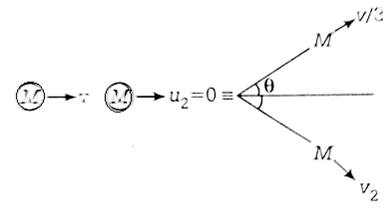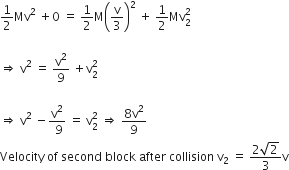NEET Exam > NEET Questions > On a frictionless surface a block of mass M m...
Start Learning for Free
On a frictionless surface a block of mass M moving at speed v collides elastically with another block of same mass M which is initially at rest. After collision the first block moves at an angle theta to its initial direction and has speed v/3. The second blocks speed after the collision is ?
Verified Answer
On a frictionless surface a block of mass M moving at speed v collides...

According to law of conservation of kinetic energy, we have


According to law of conservation of kinetic energy, we have

 This question is part of UPSC exam. View all NEET courses
This question is part of UPSC exam. View all NEET courses
Most Upvoted Answer
On a frictionless surface a block of mass M moving at speed v collides...
Analysis:
To solve this problem, we can use the principles of conservation of momentum and conservation of kinetic energy. Let's break down the steps to find the speed of the second block after the collision.
Momentum Conservation:
Before the collision, the first block has a momentum of Mv (mass times velocity), and the second block has a momentum of 0 since it is at rest. After the collision, the first block moves at an angle theta and has a speed of v/3, while the second block moves with an unknown speed. Let's assume the speed of the second block after the collision is v2.
- Initial momentum: Mv + 0 = Mv
- Final momentum: (Mv/3)cos(theta) + Mv2sin(theta)
According to the principle of momentum conservation, the initial momentum must be equal to the final momentum. Therefore, we have:
Mv = (Mv/3)cos(theta) + Mv2sin(theta)
Kinetic Energy Conservation:
Since the collision is elastic, kinetic energy is conserved. The initial kinetic energy is given by (1/2)Mv^2, and the final kinetic energy is given by (1/2)M(v/3)^2 + (1/2)Mv2^2.
- Initial kinetic energy: (1/2)Mv^2
- Final kinetic energy: (1/2)M(v/3)^2 + (1/2)Mv2^2
According to the principle of kinetic energy conservation, the initial kinetic energy must be equal to the final kinetic energy. Therefore, we have:
(1/2)Mv^2 = (1/2)M(v/3)^2 + (1/2)Mv2^2
Solving the Equations:
Now we have a system of two equations with two unknowns (theta and v2). We can solve these equations simultaneously to find the value of v2.
1) Mv = (Mv/3)cos(theta) + Mv2sin(theta)
2) (1/2)Mv^2 = (1/2)M(v/3)^2 + (1/2)Mv2^2
Simplifying equation 1, we get:
v = (v/3)cos(theta) + v2sin(theta)
Simplifying equation 2, we get:
v^2 = (v/9) + v2^2
Now, we can substitute (v/9) from equation 2 into equation 1:
v = (v/3)cos(theta) + √[(v^2 - v2^2)]
Squaring both sides of the equation, we obtain:
v^2 = (v^2/9)cos^2(theta) + (v^2 - v2^2)
Simplifying further, we get:
v^2/9 = (v^2/9)cos^2(theta) + v^2 - v2^2
Rearranging the equation, we have:
v2^2 = (v^2/9)(8 - 9cos^2(theta))
Taking the square root of both sides, we get:
v2 = v/3 * √(8 -
To solve this problem, we can use the principles of conservation of momentum and conservation of kinetic energy. Let's break down the steps to find the speed of the second block after the collision.
Momentum Conservation:
Before the collision, the first block has a momentum of Mv (mass times velocity), and the second block has a momentum of 0 since it is at rest. After the collision, the first block moves at an angle theta and has a speed of v/3, while the second block moves with an unknown speed. Let's assume the speed of the second block after the collision is v2.
- Initial momentum: Mv + 0 = Mv
- Final momentum: (Mv/3)cos(theta) + Mv2sin(theta)
According to the principle of momentum conservation, the initial momentum must be equal to the final momentum. Therefore, we have:
Mv = (Mv/3)cos(theta) + Mv2sin(theta)
Kinetic Energy Conservation:
Since the collision is elastic, kinetic energy is conserved. The initial kinetic energy is given by (1/2)Mv^2, and the final kinetic energy is given by (1/2)M(v/3)^2 + (1/2)Mv2^2.
- Initial kinetic energy: (1/2)Mv^2
- Final kinetic energy: (1/2)M(v/3)^2 + (1/2)Mv2^2
According to the principle of kinetic energy conservation, the initial kinetic energy must be equal to the final kinetic energy. Therefore, we have:
(1/2)Mv^2 = (1/2)M(v/3)^2 + (1/2)Mv2^2
Solving the Equations:
Now we have a system of two equations with two unknowns (theta and v2). We can solve these equations simultaneously to find the value of v2.
1) Mv = (Mv/3)cos(theta) + Mv2sin(theta)
2) (1/2)Mv^2 = (1/2)M(v/3)^2 + (1/2)Mv2^2
Simplifying equation 1, we get:
v = (v/3)cos(theta) + v2sin(theta)
Simplifying equation 2, we get:
v^2 = (v/9) + v2^2
Now, we can substitute (v/9) from equation 2 into equation 1:
v = (v/3)cos(theta) + √[(v^2 - v2^2)]
Squaring both sides of the equation, we obtain:
v^2 = (v^2/9)cos^2(theta) + (v^2 - v2^2)
Simplifying further, we get:
v^2/9 = (v^2/9)cos^2(theta) + v^2 - v2^2
Rearranging the equation, we have:
v2^2 = (v^2/9)(8 - 9cos^2(theta))
Taking the square root of both sides, we get:
v2 = v/3 * √(8 -
Attention NEET Students!
To make sure you are not studying endlessly, EduRev has designed NEET study material, with Structured Courses, Videos, & Test Series. Plus get personalized analysis, doubt solving and improvement plans to achieve a great score in NEET.

|
Explore Courses for NEET exam
|

|
Similar NEET Doubts
On a frictionless surface a block of mass M moving at speed v collides elastically with another block of same mass M which is initially at rest. After collision the first block moves at an angle theta to its initial direction and has speed v/3. The second blocks speed after the collision is ?
Question Description
On a frictionless surface a block of mass M moving at speed v collides elastically with another block of same mass M which is initially at rest. After collision the first block moves at an angle theta to its initial direction and has speed v/3. The second blocks speed after the collision is ? for NEET 2024 is part of NEET preparation. The Question and answers have been prepared according to the NEET exam syllabus. Information about On a frictionless surface a block of mass M moving at speed v collides elastically with another block of same mass M which is initially at rest. After collision the first block moves at an angle theta to its initial direction and has speed v/3. The second blocks speed after the collision is ? covers all topics & solutions for NEET 2024 Exam. Find important definitions, questions, meanings, examples, exercises and tests below for On a frictionless surface a block of mass M moving at speed v collides elastically with another block of same mass M which is initially at rest. After collision the first block moves at an angle theta to its initial direction and has speed v/3. The second blocks speed after the collision is ?.
On a frictionless surface a block of mass M moving at speed v collides elastically with another block of same mass M which is initially at rest. After collision the first block moves at an angle theta to its initial direction and has speed v/3. The second blocks speed after the collision is ? for NEET 2024 is part of NEET preparation. The Question and answers have been prepared according to the NEET exam syllabus. Information about On a frictionless surface a block of mass M moving at speed v collides elastically with another block of same mass M which is initially at rest. After collision the first block moves at an angle theta to its initial direction and has speed v/3. The second blocks speed after the collision is ? covers all topics & solutions for NEET 2024 Exam. Find important definitions, questions, meanings, examples, exercises and tests below for On a frictionless surface a block of mass M moving at speed v collides elastically with another block of same mass M which is initially at rest. After collision the first block moves at an angle theta to its initial direction and has speed v/3. The second blocks speed after the collision is ?.
Solutions for On a frictionless surface a block of mass M moving at speed v collides elastically with another block of same mass M which is initially at rest. After collision the first block moves at an angle theta to its initial direction and has speed v/3. The second blocks speed after the collision is ? in English & in Hindi are available as part of our courses for NEET.
Download more important topics, notes, lectures and mock test series for NEET Exam by signing up for free.
Here you can find the meaning of On a frictionless surface a block of mass M moving at speed v collides elastically with another block of same mass M which is initially at rest. After collision the first block moves at an angle theta to its initial direction and has speed v/3. The second blocks speed after the collision is ? defined & explained in the simplest way possible. Besides giving the explanation of
On a frictionless surface a block of mass M moving at speed v collides elastically with another block of same mass M which is initially at rest. After collision the first block moves at an angle theta to its initial direction and has speed v/3. The second blocks speed after the collision is ?, a detailed solution for On a frictionless surface a block of mass M moving at speed v collides elastically with another block of same mass M which is initially at rest. After collision the first block moves at an angle theta to its initial direction and has speed v/3. The second blocks speed after the collision is ? has been provided alongside types of On a frictionless surface a block of mass M moving at speed v collides elastically with another block of same mass M which is initially at rest. After collision the first block moves at an angle theta to its initial direction and has speed v/3. The second blocks speed after the collision is ? theory, EduRev gives you an
ample number of questions to practice On a frictionless surface a block of mass M moving at speed v collides elastically with another block of same mass M which is initially at rest. After collision the first block moves at an angle theta to its initial direction and has speed v/3. The second blocks speed after the collision is ? tests, examples and also practice NEET tests.

|
Explore Courses for NEET exam
|

|
Suggested Free Tests
Signup for Free!
Signup to see your scores go up within 7 days! Learn & Practice with 1000+ FREE Notes, Videos & Tests.




















